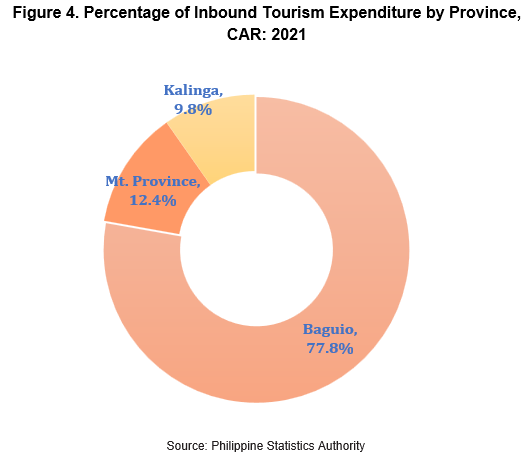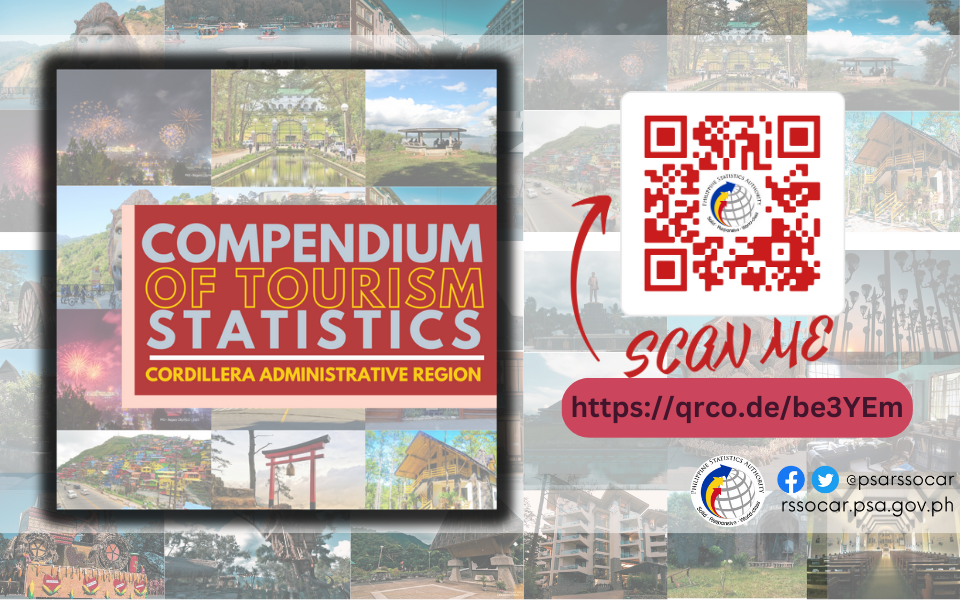The Cordillera Administrative Region (CAR) is the first amongst the regions to start estimating subnational Tourism Satellite Accounts (TSA). In line with other programs and projects of the region, CAR TSA data is part of the coverage of Republic Act No. 9593, otherwise known as "The Tourism Act of 2009" that "declares tourism as an indispensable element of the national economy and an industry of national interest and importance."
Inbound tourism comprises the activities of a non-resident visitor (foreign and overseas) within the country of reference on an inbound tourism trip (IRTS 2008, para. 2.39b). Inbound tourism consumption comprises the tourism consumption of a non-resident visitor within the economy of reference.

The average daily expenditure of an inbound tourist was estimated at PhP 7,136.77 in 2016, increased to PhP 7,179.92 in 2017, PhP 7,227.78 in 2018, and PhP 7,397.30 in 2019. It further increased to PhP 7,421.71 in 2020 and PhP 7,743.12 in 2021. The average daily expenditure of an inbound tourist in the region reflected an increasing trend throughout the six-year period. Across tourism expenditures, an inbound tourist spent most on transportation services while the least on entertainment and recreation services. The annual average growth rate of the average daily inbound tourism spending was PhP 121.27.

Total inbound tourism expenditure in 2016 was estimated at PhP 1.88 billion, decreased to PhP 1.53 billion in 2017, PhP 1.38 billion in 2018, and further decreased to PhP 1.11 billion in 2019. In 2020, it made a huge drop to PhP 154 million. Inbound tourism expenditure continued to drop to only PhP 7 million in 2021 as a result of the pandemic.
Transportation services was the main contributor to the inbound tourism expenditure across the six-year period, followed by Accommodation services for visitors, and Travel agencies and other reservation services. Meanwhile, the least contributor throughout the six-year period was Entertainment and recreation services.

Among product items, Transportation services contracted the most in 2020 with -86.3 percent, followed by Travel agencies and other reservation services with 86.1 percent, Accommodation services and Country-specific tourism services: Shopping both with -86.0 percent. Food and beverage services and Entertainment and recreation services recorded the least decline with -85.7 percent.
Entertainment and recreation services recorded the highest decline in 2021 with -95.9 percent. This was closely followed by Transportation service and Travel agencies and other reservation services, both with -95.7 percent. Food and beverage serving services declined the least with -95.4 percent.

In 2021, Baguio City accounted for the highest inbound tourism expenditure in the Cordillera with a share of 77.8 percent. Mountain Province came next with 12.4 percent, and Kalinga with 9.8 percent. Abra, Apayao, Benguet and Ifugao were still closed for inbound tourists in 2021.
(SGD)
VILLAFE P. ALIBUYOG
Regional Director
_______________________________________________________
TECHNICAL NOTES
Tourism Satellite Accounts - an accounting framework adopted by the United Nations (UN) and is designed to measure goods and services associated with tourism activities according to international standards, concepts, classifications and definitions.
Inbound Tourism - comprises the activities of a non-resident visitor (foreign and overseas) within the country of reference on an inbound tourism trip (IRTS 2008, para. 2.39b).
Inbound Tourism Consumption - comprises the tourism consumption of a non-resident visitor within the economy of reference.
Domestic Tourism - refers to the activities of a resident visitor (overnight and same-day) within the country of reference either as part of a domestic tourism trip or part of an outbound tourism trip (IRTS 2008, para. 2.39a).
Domestic Tourism Consumption - refers to the tourism consumption of a resident visitor within the economy of reference.
Internal Tourism - refers to the activities of resident (domestic) and non-resident (inbound) visitors within the country of reference as part of domestic or international trips.
Internal Tourism Consumption - refers to the tourism consumption of both resident and non-resident visitors within the economy of reference. It is the sum of domestic tourism consumption and inbound tourism consumption.
Internal Tourism Expenditure - the sum of inbound and domestic tourist expenditure.



